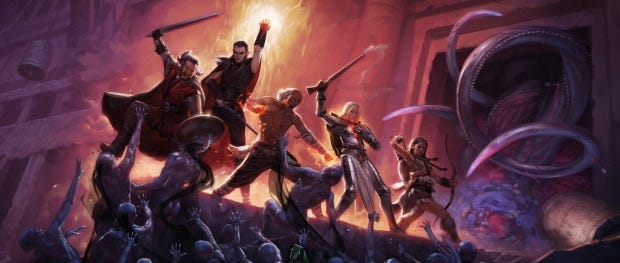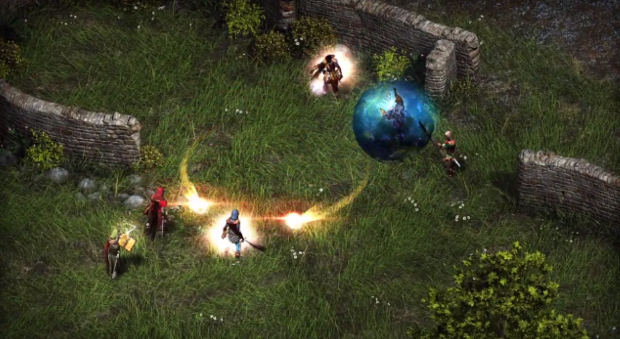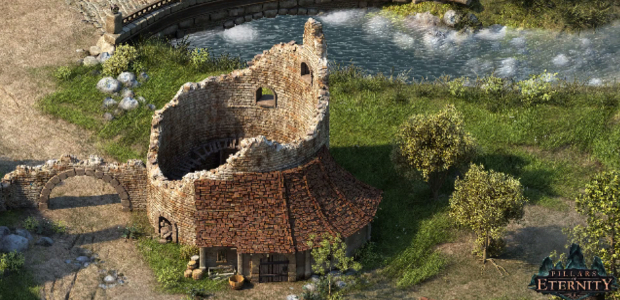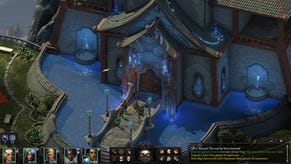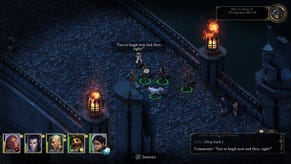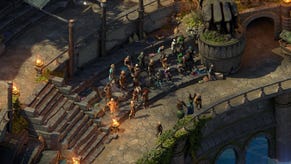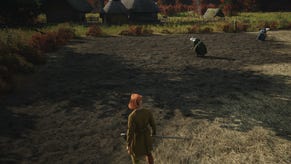Freedom And Fantasy: Pillars Of Eternity Interview
From the Strip to Infinity
Pillars of Eternity was, briefly, gaming's most successful Kickstarter, at least in terms of funds raised. Like many crowdfunded games, particularly in the early days, it's a project driven partly by nostalgia. A party-based fantasy RPG in the style of Baldur's Gate and the other Infinity Engine D&D games, it has a strong heritage to live up to. Obsidian's Josh Sawyer is the director of the game and I spoke to him late last week about theology, flagellant monks, freedom from licensing and respecting player's choices. We also talked about his desire to make a historical RPG and his previous work, particularly the design of Fallout: New Vegas.
RPS: You talk about the Infinity Engine games almost as if they were a genre in and of themselves. The fact that you went to Kickstarter may answer my question in part – but what do you think happened to that genre of games? Did publishers just turn away from them or was there more to it?
Sawyer: It was a publisher thing. Somehow it was decided that people didn’t want those kind of games anymore. I don’t think there was ever any sales data to prove that – people stopped making them, which kind of makes the argument prove itself. Make zero games of that type and there are zero sales!
It’s a self-fulfilling prophecy. That often happens with retailers and publishers though. Even at Black Isle after we stopped making Infinity Engine games, we were working on Van Burin, which would have been Fallout 3 for us, and those were 3d games but essentially still isometric. The publishers decided, even at Interplay, that people weren’t into that kind of game anymore. They wanted to go full 3d.
RPS: In terms of resources, the 2d artwork in a game like Pillars must be hugely time-consuming. Even the scripted conversation and decision sequences are illustrated. How much unique artwork have you created?
Sawyer: A lot (laughs)!
RPS: How does it compare in size to the Infinity Engine games? Have you been able to go as big as you wanted?
Sawyer: Yeah, we’re as big as we wanted. The smallest of the Infinity Engine games was Icewind Dale, which had around 80 maps, and the largest was Baldur’s Gate II, which had over 200 maps. We’re at about 150. But even Icewind Dale was a pretty big game. I feel like we have a nice amount of big city stuff, cool wildernesses and nice dungeons. It’s a good mix of those types of environment, with plenty to explore.
RPS: New Vegas in some ways felt like it landed on a sort of middle-ground between the Infinity Engine games and Fallout 3. The environments and NPCs seem more...reactive? You can probably summarise what you were aiming to do better than I can.
Sawyer: (laughs) It ws really important for me that in New Vegas players could side with lots of different factions or no factions at all. They had to be able to make choices that were meaningful throughout the game but that didn’t lock them onto specific paths. For example, you can go north of Goodsprings right at the start of the game – it is hard – but…
RPS: But you don’t want an artificial barrier?
Sawyer: Exactly. It’s a skill-based barrier rather than an invisible wall. A lot of the design was built around allowing players to find cool experiences, abilities and choices no matter what skills they choose. A lot of people were surprised by how powerful ‘Unarmed’ was but that’s intentional – if somebody wants to be an ‘Unarmed’ specialist we want them to have a good experience. That was a huge focus for me.
RPS: And that seems to be the case in Pillars as well – you created a barbarian with high intellect.
Sawyer: Exactly. Of course. People can also stick with the standard barbarian archetype if they want to, but there’s complete freedom of choice. Intellect affects the duration of abilities so a smart barbarian knows how to use his combat training effectively. A smart wizard has spells with long durations that affect large areas. A high might and constitution fighter does a lot of damage and is resistant to punishment, but his skills won’t be as effective as an intelligent fighter’s would be.
It works out that if you want to stick with the tried and true character builds, you’ll have a good idea of how to use them. But if you want to go with something more unusual or uncommon, you can do that as well.
RPS: In terms of making sure that the game is feasible for anyone to complete with so much freedom, how much work goes into balancing areas and party members? Also, when it comes to parties – I tend to pick people that I like rather than people who are useful. And in the game. Will I need to pick people with specific skillsets to progress in Pillars?
Sawyer: This actually came up in the last interview, talking about the Baldur’s Gate wizard battles. They necessitated that you have a certain class of character who can cast a certain spell. We try to not do that. Ever.
If you want to have people there because you like them, that’s cool. If you want to build a very utilitarian party, you can do that too. We never force you to have certain characters in your party. For example, the way that our health mechanic works – in combat, a priest may be useful in combat, helping to restore stamina during the fight. But if your character gets knocked out, the priest can’t bring health back. Only stamina. So they’re handy within a fight but not a necessary part of recovering after every fight.
RPS: Reminds me of playing Eye of the Beholder and realising that if I didn’t take a cleric I was fucked. Just having to restart.
Sawyer: Going all the way back to Bard’s Tale 1 – you literally need a bard to get through the cellars. I wanted to avoid that sort of stuff as much as possible. It’s about setting up the game to interact with what the player has chosen to be rather than making restrictive demands of them. We want to provide lots of tactical challenges for players but a single character type should not be the solution. There should always be a number of solutions.
RPS: Quite often there’s a square hole and I’ve only brought along round pegs.
Sawyer: Yeah.
RPS: A much broader question now. When you talk about the Infinity Engine games, is part of that the D&D style fantasy setting? Did you consider doing something more like Alpha Protocol or even Fallout within the isometric view and pauseable realtime ruleset, or was fantasy part of the appeal?
Sawyer: For the Kickstarter, we knew we’d take the high fantasy approach. We have changed certain things – we have dwarves and elves, but we don’t have orcs or halflings or gnomes. We have our own races in place of those. And you can see from the lady on the graphic there holding the gun that we’re set a little later.
Obviously it’s not Earth’s timeline but we’re a little later than is usual for fantasy, toward the Renaissance, age of exploration and colonisation. That gives the setting and the world a different feeling. But, yeah, we knew that it’d be mostly a Forgotten Realms kind of setting.
RPS: And what is the appeal of that to you personally?
Sawyer: I have to say, I don’t have a super-strong affinity for fantasy. I don’t mind playing fantasy and I don’t mind writing for fantasy. Personally, I like real historical settings.
But there’s plenty that I can do with a fantasy setting. I guess familiarity – some people would say it breeds contempt – but it allows me to think of ways to take new approaches to recognisable ideas and images. Not always intentional subversion either. People take some of this stuff for granted so we just think of new ways to approach it, and how to present these races and archetypes.
For example, monks in this world. They don’t come from an Eastern empire. They’re a domestically grown phenomenon and they’re like flagellants, disciples of pain. So as they absorb damage, they store up that pain as wounds which they can spend as a resource. What powers them is the infliction of damage on them.
RPS: I guess you can pull in a lot of the historical references as well. You said ‘age of exploration’ earlier – how much of the setting draws on actual history? Can you have fun drawing on different historical eras and making a sort of chronological cocktail?
Sawyer: Yeah, it is a lot of fun. For example, we play a lot in the game with the tensions between the people arriving at in this new area and the people who live there. In the intro, you see the caravan approaching some ruins and the guardians of those ruins think they want to loot them.
There was a civil war in this area and the people are still dealing with the aftermath of that. Also, yeah, some things are out of sync. So in this setting the printing press has not been invented, so information flow is a lot slower and more easily controlled. Writing is undertaken by monks working alone or in small monasteries.
The study of history is the study of how people have behaved in the past. When you see the ways that people have interacted, you can model those behaviours in different settings, and that’s a lot of fun.
RPS: When you come to create your own world rather than being tied to Forgotten Realms or other D&D settings, how much freedom do you have? I don’t know a huge amount about D&D outside the computer games I’ve played, so it all seems like a bit of a blank slate to me anyway, but are there things you can do now that you don’t have any license-holders looking over your shoulder? I think you’ve mentioned before having more ‘mature’ themes.
Sawyer: There are certain content boundaries in a D&D setting. It’s trickier. At different periods of time the license-holders have been more sensitive about how far they’ll allow you to transgress those boundaries. We’ve made a few big changes
One thing is that you don’t have alignment. You have reputation instead, which is a natural set of evolving qualities rather than a more rigid definition. If you behave a certain way, you gain a certain reputation. It’s a much more fitting way for NPCs to interpret who your character is. And we’re not asking people, ahead of time, to define themselves. You make choices and over time you establish a character.
As for ‘mature’, there are lots of ways to interpret that word (laughs). A lot of times mature is actually immature.
RPS: Stilettoes, severed heads and whips.
Sawyer: Yeah. We do have people running around blowing each other into gibs and all that bloody stuff but in terms of the story, we can deal with things that people might be sensitive to. For example, the Orlans, which are the small furry race, are regarded very poorly by a lot of the settlers and have a poor relationship with them. They were enslaved for a while in the Dyrwood, so there’s a lot of lingering resentment.
Also, souls are a big part of the setting and the use of animancy is important. That’s the field of study into the manipulation of souls. Reincarnation is taken for granted but there’s a lot of research happening into how souls work. They’re at the dawn of understanding the ‘physics’ of souls. Because of that, animancers are using a lot of the knowledge to do cool things but sometimes they’re also doing very bad things.
As a result of that, there’s a very mixed perception in the setting as to how animancy research should be carried out, or even if it should be carried out at all. Some people think that the gods will become very angry and that animancy might disrupt reincarnation and the process of how souls exist and are ‘made’. Others thing we need to understand how souls work so that we can improve them, by removing defects like personality defects or mental illness that can be treated.
We can explore those ideas in the setting and we can establish it in a way that it’s not self-defeated by the rules of the setting. Death is permanent in our world, other than through reincarnation itself. If you say death is a big deal in Forgotten Realms, it’s hard to take that seriously as a narrative or mechanical device because so much of that setting contradicts the permanence of death.
RPS: What is the actual status of gods in this world? As I say that out loud, it seems like a fairly hefty question.
Sawyer: It is! The gods are important to a lot of people. They’re fickle in how they interact with mortals.
RPS: But they do interact directly?
Sawyer: Yes. The last big time that happened – and this is one of the reasons people are very afraid of what animancy could mean – was something called The Saint’s War, which happened fifteen years ago in the setting. A god slowly seemed to take control of a farmer named Waidwen. He eventually became the spiritual leader of a country north of the Dyrwood and led a crusade into the Dyrwood.
He was only stopped because the followers of another religion built a contraption called the Godhammer Bomb. They basically blew Waidwen god up and they haven’t heard anything from the god that controlled him since. So they’re thinking…
RPS: Did we kill a god?
Sawyer: Yeah! And are the other gods mad at us? Will they become angrier if we carry on pursuing our research into souls? But people don’t fully understand the gods – in Forgotten Realms, the gods are well understood, as is cosmology and life and death. In this setting, people have beliefs but they don’t have a lot of proof for those beliefs.
RPS: In terms of telling a story within a new setting, how much work does the player’s personal narrative have to in order to function as an introduction to the world as well?
Sawyer: Part of the reason you pick your background is so that it’s clear you’re from a different place. Your character is a newcomer as well. So interacting with characters, you learn about the conflict within the area – which is the thread you follow – and the history of the region as well. We avoid exposition as much as possible.
I’m a big believer in having characters conveying expositional things in terms of their own personality and situation. It helps to draw players into their lives and also does the work in communicating the plot.
RPS: With so many familiar tropes – a word I hate – how do you ensure that players feel like strangers in a strange land?
Sawyer: We set up circumstances like the last scene you saw. You come across something that you can’t really make sense of. It’s like the end of a chapter where you go…whaaaat? And then you turn the page and the next chapter is following a completely different character!
We want players to see the robed figures chanting and make assumptions about what they’re doing. Not too uncommon in a fantasy game, right? And they’re waving their arms, which is the kind of thing these guys tend to do. But then there’s a huge machine and it’s drawing in the winds, which you saw pulling peoples’ souls out earlier. So that’s all connected but what does it all mean? And what is it your role?
RPS: A slightly more prosaic question after dealing with god-killing and theology – but can players switch party members at any time?
Sawyer: There are eight characters and you can have five, plus your own, at any one time. And, yes, once you’ve discovered them you can swap and change. You can also make replacement party members, in a more Icewind Dale style. They’re blank slates with no written character. You pay money in-game to create them. One of the things our Kickstarter backers backed was the stronghold, which all of your companions hang out at when you’re not using them.
RPS: Is there conflict between characters?
Sawyer: Yeah. Some have very strong beliefs and they don’t always see eye to eye. But unlike Baldur’s Gate they’re not based on alignment, they’re based entirely on personalities.
RPS: And how does the player character come to be the leader of the party – he or she is a newcomer but somehow takes charge?
Sawyer: The land isn’t your land but the conflict is yours. You are at the centre of your own conflict. That means you are the most interested party. It’s like…I’m going to use a Speed reference here – Keanu Reeves doesn’t know anything about buses but he has to make sure that this particular bus keeps going and doesn’t explode! You’re in a circumstance like that.
You don't necessarily understand the entire situation and you're not part of this conflict at first, but events bring your personal story into the wider picture. It becomes intertwined. The other characters in your party have an interest in that central conflict as well but it isn't directly about them. They're not driving the bus.
The conversation continues next week, with extensive thoughts on New Vegas, the Kickstarter process and working with Paradox.
